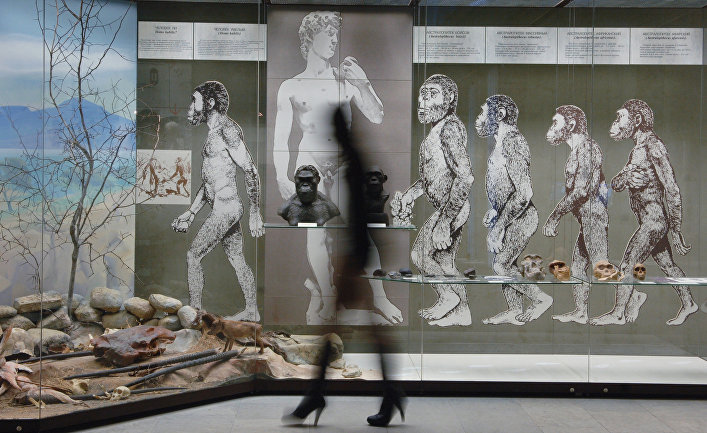
Much of modern biology is based on the theory of Charles Darwin (Charles Darwin) about the evolution of how the process of natural selection is when nature selects the fittest and most adapted to environmental conditions organisms for reproduction, increasing population, and survival. This process is also called adaptation, and adaptive are those traits that best help the survival of the organism. Change and consolidation of the new modifications of organisms appear and develop. In the 1850s, when Darwin described the engine of natural selection, was not yet known about the underlying molecular mechanisms. But advances in genetics and molecular biology of the last century outlined the main principles of modern neodarwinists theory as to how the evolution of: DNA sequences mutate randomly and multiply and dominate those organisms whose DNA is best adapted to the environment. These species predominate until environmental conditions begin to change and the engine of evolution does not start again.
But if we assume that other molecular mechanisms play a role in the development of species, this explanation of evolution is incomplete. The problem of Darwin’s theory lies in the fact that while the types of produce more adaptive properties (which in biology are called phenotypes), the rate of occurrence of random mutations in DNA sequences is too small, that she could explain many of the observed changes. Knowledgeable about the problem, scientists propose a number of compensatory genetic mechanisms: genetic drift, when a serious genetic changes occur within a small group of organisms, or epistasis when one gene suppresses the other. And that’s just two of many examples.
But even given such mechanisms, the level of genetic mutations among complex organisms such as humans, is much lower than the frequency of changes in the number of signs from regulation of metabolism to disease resistance. A quick demonstration of the diversity of signs is difficult to explain only by the methods of classical genetics and neodarwinism theory. To quote the eminent evolutionary biologist Dr Jonathan B. L. bard (Jonathan B L Bard), perefrazirovala T. S. Eliot (T S Eliot): “Between the phenotype and genotype of the fallen shadow”.
Problematic aspects of Darwin’s theory outside of the theory of evolution and extend to other areas of biology and Biomedicine. For example, if our traits are determined by heredity, then why do identical twins with the same set of genes, as a rule, are different diseases? And why only a small number (often less than 1%) suffering from specific diseases have a common genetic mutation? If the rate of mutations is random and uniform, then why the share of many diseases has increased tenfold in just two decades? Why are hundreds of types of environmental pollution are changing the circumstances of the debut of the disease, but not the DNA sequence of cases? In evolution and Biomedicine, the rate of formation of deviations from the phenotypic characteristics is much higher than the speed of genetic changes and mutations, but why?
Some answers can be found in the ideas of Jean-Baptiste Lamarck (Jean-Baptiste Lamarck), published 50 years before the publication of the works of Darwin. Lamarck’s theory, has long sent to the dustbin of history, among others, argued that “environment modifies the properties that are then inherited by new generations.” Lamarck was Professor of invertebrate Zoology at the National Museum of natural history in Paris, and at the end of XVIII — early XIX century, he studied a variety of organisms, including insects and worms. He introduced into the scientific lexicon the words “biology” and “invertebrate”, he was also the author of several books about biology, invertebrates and evolution. Despite the remarkable scientific career of Lamarck with his blasphemous ideas of evolutionary denied many of his contemporaries, as well as scientists for the next 200 years.
Initially, Lamarck was condemned as a religious heretic, and in our time his name is mentioned only in jest, because of the conservatism of science, and especially the sacrosanct theory of evolution of Darwin. At the end of my academic career Lamarck himself changed his beliefs: even without evidence from molecular biology, he saw that random changes can’t be a full proof of his theory.
The question is this: if a genetic mutation affects not only natural selection, what are the molecular forces that form the complete set of changes in the signs necessary to complete the work of natural selection? One of the clues was found almost a century after Darwin introduced his theory. In 1953, when James Watson (James Watson) and Francis Crick (Francis Crick) unraveling the mysteries of DNA and the double helix, an evolutionary biologist Conrad Waddington (Conrad Waddington) from the University of Edinburgh reported that external chemical stimuli or temperature changes during embryonic development can cause different variants of the structure of the wing in Drosophila. Changes the action of the scientist caused organisms of one generation subsequently passed on to offspring. To explain the mechanism of rapid changes, Waddington coined the modern term “epigenetics”. It should be noted that Waddington was aware of the significance of his discovery may have for the theory of evolution, even before Watson and Crick deduced the structure of DNA. The changes in the structure of the wings of one generation of fruit flies confirmed the initial idea of the heretic Lamarck. It turned out that the environment is able to directly influence the characteristics of the organism.
Although Waddington and describe the General role of epigenetics, molecular elements and mechanisms he didn’t know any more than Darwin or Lamarck. But the deeper molecular biology, decodes the functioning of life, the more meaning filled with the concept of Waddington and of Lamarck. Indeed, the vast majority of environmental factors can not directly influence the molecular sequence of DNA, but they are controlled by numerous epigenetic mechanisms that control DNA functions: start or extinguish the expression of genes, dictating the ways of expression in cells of the protein product of our genes.
Today there is a precise definition of epigenetics is a set of molecular determinants, the functioning of DNA and what genes appear, regardless of the DNA sequence. Epigenetics includes a number of molecular processes that significantly affect the activity of the genome without changing the DNA sequence of the genes.
One of the most common processes of this type — methylation of DNA, when DNA join molecular components called methyl groups (composed of methane), which turn on and off genes and regulate the level of gene expression. It has been shown that environmental factors such as temperature and emotional stress, can change the course of DNA methylation and the changes can become part of the ongoing program and start to be transmitted by inheritance to succeeding generations. This process is known as epigenetic inheritance.
Another important epigenetic process, discovered in recent years, modification of histones. Histones are proteins that attach to DNA and change its structure, and DNA, in turn, is wrapped around histones, like beads on a string. The combination of DNA and histones is called chromatin structures, and spirals, loops and bundles in chromatin is a response to the stress resulting from the effects of the environment and can permanently change gene expression.
Recently, scientists documented the process of RNA methylation, in which methyl groups joined to the auxiliary molecules by altering gene expression and protein production of subsequent generations. In addition, the so-called non-coding RNAS — small RNA molecules that bind to DNA, RNA and proteins, also changes gene expression regardless of the DNA sequence.
All of these mechanisms of epigenetics are critical and play an important role in the molecular regulation of DNA functions. From this it follows that the rules of biology never are based only on genetic or epigenetic only processes. On the contrary, the processes of genetics and epigenetics are intertwined. One does not work without the other.
The laws of epigenetics, so the change could affect evolution, it must be inherited by subsequent generations in the form of DNA sequences or gene mutations. But epigenetic inheritance is not correlated with many of the Mendel’s laws applicable to classical genetics or neodarwinists the theory of evolution. According to these rules, the DNA sequences and genes functioning in isolation like particles: during playback, the “particles” from one parent at random together with a pair from the other parent, resulting in novel DNA sequences and a new manifestation of hereditary traits.
Epigenetic inheritance, in contrast, occurs when germ line (sperm or eggs) transmit epigenetic information from one generation to another even in the absence of direct continuous environmental factors. These factors, like the stress from the impact of the environment, especially strong in the process of embryonic development, for example, in the period when the sex organs of the fetus transformirovalsya to testes in male individuals and the ovaries in female animals, to a later age to produce sperm and egg. Indeed, the environmental factors during this critical time can cause permanent epigenetic changes through DNA methylation, histone modifications and restructuring of non-coding RNAS.
In 2000 my team at the University of Washington has received evidence that non-genetic forms of inheritance, and they are quite convincing. The conclusions that my group published in Science in 2005 showed that chemicals in the environment able to facilitate the transfer by inheritance of certain diseases in three generations of rats and then even in the absence of prolonged exposure. Later, i.e. in the last ten years, this phenomenon is documented in many laboratories for different types. One example is the report Graham Burge (Graham Burdge) and his team from the British University of Southampton about how increased feeding of rats caused an epigenetic metabolic disorders for the next three generations.
In other work Right sung (Sibum Sung) and his colleagues at the University of Texas at Austin found that drought and temperature fluctuations cause epigenetic evolution of plants, resulting in changes in the processes of their growth and flowering for several generations. According to the results of several studies, stress from environmental exposures may contribute to epigenetic changes that are transmitted to subsequent generations and cause them to have diseases. A recent study Gerlinde Metz (Gerlinde Metz) and her colleagues from the University of Lethbridge in Canada showed that when pregnant rats were deprived of freedom of movement or forced them to sail, there is epigenetic damage that threatened the newborn cubs. This delivery process was in motion a chain of inheritance of epigenetic abnormalities in several generations along the line subjected to stress females. Now the role of stress under the influence of the environment in epigenetic inheritance of disease in several generations is confirmed by several studies.
Epigenetic inheritance is influenced by environmental factors observed in plants, insects, fish, birds, rodents, pigs and humans. Consequently, it is very sustainable. It has been shown that epigenetic transgenerational inheritance of a variety of phenotypic traits and diseases occurs in most organisms, no less than ten generations, and the most extensive research has studied hundreds of generations of plants. For example, Carl Linnaeus (Carl Linnaeus) in the eighteenth century noticed that flowering in plants can be caused by fever, and later found out that this is due to modifications of DNA methylation of the first plants in the chain, and the symptom persists for a hundred generations. Worms symptoms, caused by changes in diet, apply to 50 generations. In mammals, which each generation lives longer, we had emerged under the influence of toxins deviations from the norm, extending to the next ten generations. In most of these studies shows that the transgenerational traits continue and not degenerate. Even in the experiment of Waddington flies it was about 16 generations, and all had altered the properties that continue to be passed down from one generation to another to this day.
Changes in the environment literally change the biology, and it largely coincides with the supposition of Lamarck. Even if the effect is short-lived, biological modification, which is manifested in certain characteristics or diseases are passed between generations.
Environment plays a significant role in evolution. In Darwinian sense, it determines which individuals and species will survive in the inexorable machine of natural selection. But a large number of environmental factors can also influence the evolution and biology directly, i.e. by means of epigenetics: properties of the organism vary under the influence of temperature or light, or in response to power settings, such as a diet high in fat or caloric restriction. Numerous chemicals and toxins from plants and the environment can affect phenotypic change and health.
One of the examples that we studied in our lab include chemical effects on the variability of symptoms and diseases. We have studied the ability of the toxin vinclozolin, most commonly used in agriculture as a fungicide, influence characteristics through epigenetic changes. First, we subjected pregnant female rats to the effects of this fungicide, then wait three generations of her offspring, no longer applying the toxin. Almost all the males there was a decrease in the number and viability of sperm, but with age and cases of infertility. We also observed a number of other disease States as in males and females, which from the direct impact of the toxin was separated by three generations. Among these conditions were violations of the functions of the testicles, ovaries, kidneys, prostate, mammary glands and brain. Appropriate epigenetic changes in sperm cells involve changes in DNA methylation and expression of non-coding RNA.
As shown by our study, exposure to toxin vinclozolin resulted in sexual selection for three generations to come. To observe sexual selection, or preference of a partner, which is the main driving force of evolution from the time when Darwin presented his theory, females from other litters were given the opportunity to choose between males-descendants of the exposed individuals and other males. The vast majority of cases, females chose those who were absent epigenetic transgenerational changes, i.e. males whose ancestors weren’t exposed to the toxin. In other words, the effect of the fungicide forever changed the epigenetics of sperm descendants, which in turn points to the hereditary nature of the characteristics of sexual selection, which, as you know, is committed to reducing the spread of genes in a population and directly influences the evolution at the microevolutionary scale.
In another recent study we have touched upon the macro-developmental scale of evolution — speciation. One of the classic examples of speciation — Darwin’s finches on the Galapagos Islands. A group of finches of the same species gave sixteen new species, and they differ in size and had a variety of other features, such as the structure of the beak. Our team decided to study five different types. We followed the mutations of DNA sequences from one species to another, but the number of epigenetic changes of DNA methylation (epimetsi) was higher and more correlated with phylogenetic distance between the species (lineage). Although currently more attention is paid to neodarwinists genetic concepts, our findings suggest the possibility that epigenetics plays a role in speciation and evolution of Darwin’s finches.
Recognition of the role of epigenetics in evolution continues to grow. One interesting study that compares the DNA of a Neanderthal and a human, and it is clear that genetic differences are much less pronounced than epigenetic changes of DNA methylation in genomes. In short, the Union neolamarckians and neodarwinists concepts in one theory provides a much more effective molecular basis of evolution.
On the evolution and impact neodarwinists and neolamarckians mechanisms, and they, apparently, are closely linked. Indeed, because epigenetics the environment can increase the variability of characteristics within one population, it extends the capabilities of natural selection, in which adaptive traits dominate over all others. Classic neodarwinists evolution is based on genetic mutations and variations of genes as the main molecular mechanism that creates the diversity. To these mechanisms is added the phenomenon of epigenetics, which directly increases the number of variations on signs, which increases the chances of the environment to become a mediator in the process of evolution and natural selection.
A critical additional consideration is the ability of epigenetics can change the genome stability and thus directly cause the genetic mutations that are observed in cancer biology. Such genetic mutations include variations in the number of copies (the number of repetitions of short sequences of DNA) and point mutations (changing a single nucleotide out of the DNA sequence) in subsequent generations. It is known that almost all genetic mutations are epigenetic predecessors — the changes increase vulnerability to mutations. We saw a direct impact of the environment in the first generation did not cause genetic mutations, but lead to epigenetic changes in subsequent generations showed the increase in the number of genetic mutations. Because epigenetics associated with the variability of the signs, and with mutations, it accelerates the engine of evolution, which can not make Darwinian mechanisms alone.
Towards a unified theory of evolution, many are skeptical, especially in light of the paradigm of genetic determinism, which is more than 100 years, have affected the biological disciplines. Genetic determinism sees DNA as the basic building block of biology, and DNA sequence — as an absolute means of control at the molecular level.
Probably the pentacle of genetic determinism was the sequencing of the human genome, the purpose of which was to be a decisive proof of the primacy of the gene. Predicted genome-wide study was to identify biological markers of normal and abnormal phenomena of life and highlight the background diseases. But after sequencing the main hypothesis of genetic determinism — the assertion that a large part of biology and human diseases can be interpreted through the prism of genetics, has not been confirmed.
Studied genetics for many generations of scientists and the public, but few have addressed the relatively new science of epigenetics: in practice, the inclusion of epigenetics in the doctrine of elements molecular biology and evolution in the face of resistance. And Watson, who played a role in the discovery of the structure of DNA, Francis Collins (Francis Collins), whose work in the field of genome sequencing DNA was very significant, initially questioned the importance of the factor of epigenetics, but today both are more favorable. Francis Collins, now head of the U.S. National institutes of health. However, it is not surprising that after 100 years of genetic determinism many are resisting the paradigm shift.
A month later, after I put forward a unified theory of evolution, and it was published in Genome Biology and Evolution in 2015, David penny (David Penny) of Massey University in New Zealand suggested that epigenetics is just a component of the genetics of hereditary characteristics. Other recent publications, for example, article Emma Whitelaw (Emma Whitelaw) from Australia’s La Trobe University, challenged the concept lamarkianism epigenetic inheritance in mammals.
Despite the opposition, I am convinced that we have reached the point where a paradigm shift is imminent. The recognition that epigenetics played a role in evolution does not deny the importance of genetics. One who considers neolamarckians ideas, does not challenge the classical theory neodarwinists. The recognized doctrine is important and accurate, but they are part of a more extensive and detailed material that expands the boundaries of our understanding, bringing together all of our observations into a unified whole. Unified theory shows how the environment simultaneously affects phenotypic diversity and facilitates natural selection, as shown in the diagram above.
More and more evolutionary biologists are demonstrating a growing interest in the role of epigenetics, has created a series of mathematical models, combining genetics and epigenetics in a single system, and this work has really paid off. Look at epigenetics as an additional molecular mechanism helps to understand phenomena such as genetic drift, genetic assimilation (when a symptom developed in response to environmental conditions, is ultimately encoded in the genes) and even the theory of neutral evolution, according to which most changes do not occur in response to natural selection, and random. Introducing the advanced molecular mechanism of the observations of biologists, the new models create a more deep, subtle and accurate scenario of evolution in General.
All together, these findings require us to rethink the previous standard, genetic determinism, in search of spaces. In 1962 Thomas Kuhn (Thomas Kuhn) assumed that when the current paradigm there are anomalies, it is necessary to pay attention to new knowledge: thus was born the scientific revolution.
Unified theory of evolution should combine neodarwinists and neolamarckians aspects, in order to expand our understanding of how the environment affects the evolutionary process. It is impossible for Darwin to dismiss the contribution of Lamarck more than 200 years ago. On the contrary, it must be taken into consideration to create a more convincing and comprehensive theory. Similarly, it is impossible to consider genetics and epigenetics as conflicting region, on the contrary, they should be combined to obtain a broader variety of molecular factors and use them to explain what controls our life.







